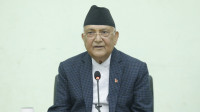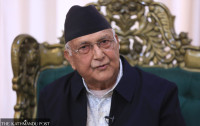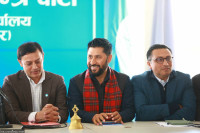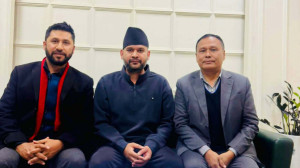Politics
Two years since the birth of the Nepal Communist Party, not much to show except for infighting and power politics
The party had the possibility of transforming the country, given its massive mandate and overwhelming strength. But it has squandered all opportunity, say analysts.%20(1).jpg&w=900&height=601)
Tika R Pradhan
Two years ago, when the then CPN-UML and CPN (Maoist Centre) announced their merger, many called it an extraordinary moment for Nepal’s communist movement. KP Sharma Oli and Pushpa Kamal Dahal, who were leading the UML and Maoist parties, respectively, declared themselves co-pilots of the newly minted Nepal Communist Party, the largest communist force in Nepal’s history.
The Oli-Dahal jet, however, met with turbulence, almost immediately, and even two years on, still continues to struggle to cruise smoothly. Party insiders and analysts say the unification was riddled with suspicion, which has only grown of late.
The party is currently on the verge of a split with the relationship of the two once-cordial co-chairs at rock bottom. The party has organised itself into factions, with two top leaders constantly jostling for support.
“Two years after the merger, Oli and Dahal, who had formed the party by trusting each other, see one other as adversaries—suspecting each statement the other makes,” said Yubaraj Chaulagain, a central committee member.
At least half a dozen leaders the Post spoke to blamed the top leadership for the woes of the country’s largest communist party.
When the two parties came together in an electoral alliance for the 2017 polls, no one had expected that they would go on to merge, given their fractious history. But the two top leaders managed to put aside their differences and agree to the merger, albeit on the condition that they would lead government for two-and-a-half years each.
Party leaders, party cadre and well-wishers were very much excited, saying that the merger would provide a new dimension to the communist movement, not just in Nepal but in South Asia and the world.
In terms of size, the Nepal Communist Party is the fourth largest in Asia, after China, Vietnam and North Korea in terms of party members. But it is among the strongest governments ever in the history of modern Nepal, with a near two-thirds majority in the federal Parliament, controlling six out of seven provincial governments and 60 percent of the 753 local-level governments.
“But things turned sour by the day,” said Dilu Panta, a central committee member. “People started to feel uneasy and suffocated as the top leadership continued to fight with each other for their own petty interests.”
When leaders announced the merger, they had promised to complete the merger process within three months. But Saturday marks the second anniversary of the party merger and the process remains incomplete. The party general convention is nowhere on the party’s agenda for discussion.
According to Haribol Gajurel, a standing committee member, it’s unfortunate that the party has yet to complete the merger and that the general convention is a distant dream.
“We cannot expect to have a proper party when the leadership works unilaterally,” said Gajurel. “We had dreamt of ruling the country for 25-30 years while merging the two parties, but that dream has gradually been shattered due to the interests of the top leaders.”
The resentment expressed by party leaders is not unfounded. The two years of the Nepal Communist Party have been marked by a constant tussle between Oli and Dahal; while the former has attempted to run the party and government as he saw fit, Dahal has increasingly chafed at being sidelined.
The problems in the party erupted all because Oli and Dahal failed to manage power sharing between them, say analysts.
“There are two reasons behind the ruling party’s crisis—Oli and Dahal’s failure to manage power sharing and a power play citing the upcoming national convention,” said Jhalak Subedi, a political commentator who follows Nepali left politics.
After Oli continued to exercise power unilaterally both in government and the party bypassing Dahal, the latter forged a strong alliance with a number of Oli’s former party comrades—Madhav Nepal, Jhalanath Khanal and Bamdev Gautam. While the Nepal Communist Party had long remained steadfastly allied along former party lines, Nepal, Khanal and Gautam had all felt increasingly sidelined within the party, with Oli monopolising decision-making. They broke convention to ally with Dahal, prompting a near crisis in the party. Oli’s opponents called for his resignation as prime minister but the ever wily Oli managed to break the alliance and retain his position, although by a hair’s breadth.
This latest crisis, according to Subedi, was sorted out by the hectic movement of second-rung leaders, and it is they who need to be included in the decision-making circle.
According to Subedi, the problems in the party will remain as long as decision-making in the party remains the province of a few select leaders and ignores influential second-rung leaders like Shankar Pokhrel, Prithvi Subba Gurung, Barshaman Pun, Ghanashyam Bhusal and Janardan Sharma.
But there are those who believe that the foundation of the party’s merger itself was faulty, as the union was not driven by ideology but was simply a move to gain state power.
“Unity prompted by a desire to capture state power will collapse any time one feels that the possibility of power is over,” political analyst Shyam Shrestha told the Post.
According to Shrestha, a communist force of the Nepal Communist Party’s size and strength could’ve maintained unity by enacting progressive policies that the constituent parties had committed to in their election manifestos. But none of the policies were ever implemented, showing that ideology was never the unifying factor, said Shrestha.
“Instead, the budget for agriculture was slashed to Rs40 billion from Rs90 billion,” he said. “Party leaders were influenced by mediators and mafia groups who helped them stay in power.”
All along, the top leadership of the party has remained inward-looking, too focussed on its own internal power dynamics to even think about the people at large.
“The ruling party has two opportunities to gain some sympathy from the people—the coronavirus crisis and the border dispute—if it can successfully handle them,” Shrestha said. “Else, I don’t see the future of the ruling party.”
Amidst the Covid-19 pandemic, ruling party shenanigans have already earned it much criticism for not focusing on the crisis at hand and instead getting bogged in internal politics. Analysts fear the same thing could happen with the ongoing border dispute with India over Lipulekh.
“Despite its overwhelming strength, which rarely comes in history, the party has squandered all its opportunities to transform the country,” Shrestha said.




 5.55°C Kathmandu
5.55°C Kathmandu















